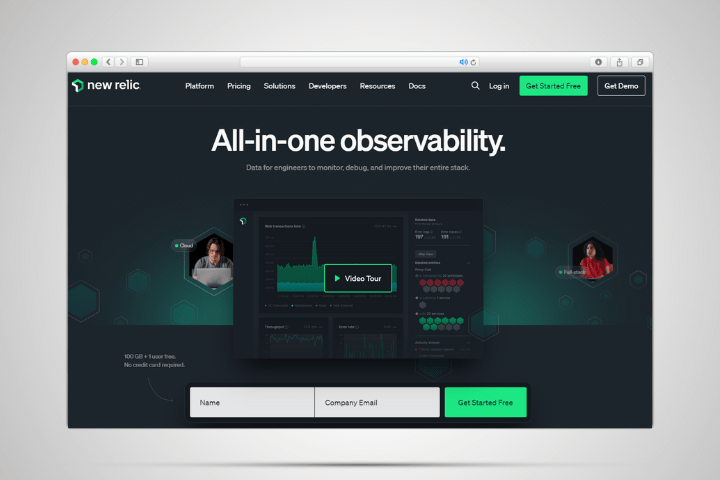New Relic: How To Get Synthetics Monitoring to Work in New Relic?

Introduction
The fast-paced nature of contemporary software development demands optimal performance and reliability. Tools that provide observations on the condition and functionality of the applications are very necessary instruments for those organizations aspiring to offer impeccable user experiences. New Relic comes as a leader in application performance monitoring (APM), which has an array of solutions tailored to monitor, diagnose, and optimize the software’s performance. The focus of this article is on New Relic, its characteristics, and also the details related to Synthetics Monitoring – an important part of ensuring the application strength.
What is New Relic?
New Relic is a full-fledged observability platform that offers real-time analytics on the functioning of software applications. Since its establishment in 2008, New Relic has become a very important partner for developers, operations teams, and business units, with a lineup of tools to monitor applications for any bugs and glitches and enhance performance. The capabilities of the platform are APM, Infrastructure Monitoring, Logs, and many others.
How to get synthetics monitoring to work in new Relic?
1. Understanding Synthetics Monitoring in the New Relic
Simulation of user actions in Synthetics Monitoring New Relic is a tool that allows for the proactive monitoring of your applications. This includes a simulation of the user’s behavior, for which you will identify and fix any potential issues before they affect the real users. First, go to the New Relic dashboard and find the Synthetics tab.
2. Setting Up Synthetics Monitors
Construction of monitors in New Relic Synthetics includes crafting scripted tests for different situations, including transaction flows, API endpoints, or individual user paths. These scripts may be written in Selenium WebDriver, which makes it possible to use them for web applications. After the monitors have been installed, they can be scheduled to run periodically, giving an ongoing picture of the application’s health.
3. Analyzing Synthetics Data
The true benefit of Synthetics Monitoring is the offering of actionable insights. You can analyze the response times, error rates, and so on that come from synthetic tests using New Relic. Use the given metrics to spot performance bottlenecks and optimize critical paths, then improve overall user satisfaction.
4. Combining Synthetics with the APM and Infrastructure Monitoring
To pursue an inclusive strategy for application observability, the integration of Synthetics Monitoring with APM and Infrastructure Monitoring in New Relic is a really great step. This consolidation ensures the application performance visibility, from code-level insights to infrastructure health, allowing for faster RCA and resolution. This is how to get synthetics monitoring to work in New Relic.
New Relic Careers
Being a pioneer in the tech world, it is New Relic that provides professionals devoted to application performance and monitoring with many attractive career prospects. The company’s focus on innovation and a dynamic working environment makes it very popular among those who are looking for jobs that require intelligence. These careers associated with New Relic include engineering, product management, sales, and marketing, among others.
New Relic Interview Questions
Training for the New Relic interview is an enormous task that demands integrative knowledge of the application performance monitoring industry, new real products, and best practices. Sample interview questions may include:
- What are the main characteristics of the New Relic APM?
- What role does synthetic monitoring play in the proactive monitoring of applications?
- What are the advantages of utilizing APM, infrastructure monitoring, and synthetics in New Relic?
- Discuss a problem situation where New Relic APM was used to identify and fix the performance issue.
- What is your method in scripting the tests for Synthetics?
New Relic Training and Certification
Training programs and certifications are offered to enable the users to acquire the skills required for a successful implementation of New Relic. These programs provide a wide variety of topics from beginner use to advanced debugging and also performance enhancement. These certifications attest to the professional’s skills to use New Relic for app monitoring and managing its performance.
New Relic Alternatives
Although New Relic is a very notable observability tool, one should think about some other options that may be better suited to certain organization’s demands. A notable competitor is Datadog, a cloud monitoring system that provides a similar functionality. It’s time to compare Datadog and also New Relic.
Datadog vs. New Relic
1. Features and Capabilities
While Datadog and New Relic offer complete solutions in terms of monitoring, their features vary. New Relic promotes application-centric monitoring, as it allows for the provision of detailed information on code performance. While Datadog offers a more comprehensive infrastructure monitoring solution, it is also best suited for enterprises with heterogeneous technology stacks.
2. Ease of Use
A monitoring platform should be very easy to use. It is known that New Relic’s intuitive interface and user-friendly dashboards make it very famous. However, Datadog is very powerful, but it may have a relatively steep learning curve because of its many features. The difference between them is often a matter of preference by the user and the monitoring needs.
3. Integration Ecosystem
Both of these platforms allow for many integrations with the popular tools and services. New Relic specializes in deep integrations with the app frameworks and also languages. Being a more comprehensive monitoring platform, Datadog has a lot of integration capabilities spanning over various cloud platform providers and also databases, along with many other third-party tools.
4. Scalability and Pricing
Scalability is a very important factor to consider in organizations that are growing very fast. Also, scalability is the real strength of Datadog, which works really great for any type of business. Pricing models for both platforms vary, with factors such as the number of monitored hosts, metrics, and features influencing costs. Organizations should carefully evaluate their specific needs and budget constraints before making a decision.
Conclusion: How To Get Synthetics Monitoring to Work in New Relic?
Monitoring and observability are essential to building high-performing software in the ever-changing software development landscape. With its complete set of tools, New Relic leads application performance monitoring. New Relic’s Synthetics Monitoring helps firms identify and resolve issues before they affect users. Innovation and a vibrant work atmosphere combine at New Relic for tech professionals seeking lucrative employment. New Relic interviews demand knowledge of APM, Synthetics Monitoring, and integration techniques.
New Relic offers training and certification programs to improve platform use. However, alternatives like Datadog may better meet organizational goals based on functionality, ease of use, integration, and scalability. Whether you choose New Relic or Datadog, your monitoring system should match your organization’s goals, technological stack, and scalability needs. Investment in comprehensive monitoring procedures promotes stable, high-performance applications, improving user experience and corporate success.
Also Read: Play Blooket – Gamifying Learning And Revolutionizing Education


